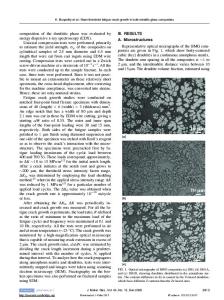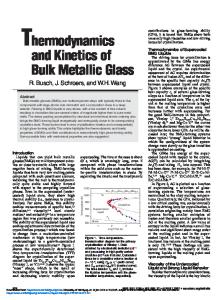Internal Stresses in Bulk Metallic Glass Matrix Composites
- PDF / 153,885 Bytes
- 6 Pages / 612 x 792 pts (letter) Page_size
- 81 Downloads / 383 Views
Internal Stresses in Bulk Metallic Glass Matrix Composites Ersan Üstündag, Danut Dragoi, Bjorn Clausen, Donald Brown1, Mark A. M. Bourke1, Dorian K. Balch2 and David C. Dunand2 Department of Materials Science, California Institute of Technology, Pasadena, CA 91125, USA (1) Los Alamos Neutron Science Center, Los Alamos National Laboratory, Los Alamos, NM 87545, USA (2) Department of Materials Science and Engineering, Northwestern University, Evanston, IL 60208, USA ABSTRACT Composites consisting of a bulk metallic glass (BMG) matrix and metallic fibers or particulates have been shown to exhibit superior mechanical properties as compared to monolithic BMGs. To understand the role of reinforcements in this improvement, it is necessary to investigate the state of internal stresses in these composites. These stresses arise from the thermal expansion mismatch between the reinforcement and the matrix, as well as the elastic and plastic incompatibilities between the two phases. Neutron diffraction and synchrotron X-ray diffraction were used to measure these mismatch-induced stresses in BMG-matrix composites with various reinforcements: continuous W fibers, W or Ta particles, and dendritic, in-situ formed precipitates. The results are compared to numerical and analytical predictions of internal stresses. INTRODUCTION Bulk metallic glasses (BMGs) have recently attracted widespread interest due to the development of new alloys that yield a glassy structure even with “conventional” metal processing such as casting [1]. The unique properties of BMGs potentially place them among significant engineering materials: very high strength (1.9 GPa) and fracture toughness (40-55 MPa.m1/2), a near theoretical specific strength, excellent wear and corrosion resistance, and a high elastic strain limit of up to 2% [2,3]. A major drawback of BMGs is that they fail catastrophically when unconstrained (e.g., in uniaxial tension) by forming localized shear bands. To avoid this and to obtain more damage tolerant BMGs, they are reinforced with fibers or particulates [4,5,6]. These studies demonstrated that the composite approach could be quite beneficial. The reinforcements seem to interact with the shear bands and sometimes act as obstacles against their propagation. Despite these significant improvements, there are a number of unresolved fundamental issues about how exactly the reinforcements interact with the shear bands. In addition, the ‘best’ reinforcement and its morphology are yet to be identified. A critical issue in the BMG-matrix composites is the presence of internal stresses. These stresses are either due to the coefficient of thermal expansion (CTE) mismatch between the matrix and the reinforcements or they arise from the elastic and plastic incompatibilities between them during mechanical loading. Since these stresses are predicted to reach several hundred MPa (4), they are expected to significantly influence the mechanical behavior of the composites. As part of a systematic study on the interactions between the matrix and reinforce
Data Loading...











